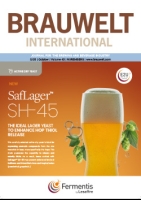Production and filling conditions as well as the heat recovery system in the brewhouse must be taken into account in order to arrive at a proper basis for sizing a boiler plant.
The Oettinger Company Group has entered the field of canned beer production. By commissioning a new canning line from KHS at its Gotha brewing plant last summer, Oettinger now also supplies the discount sector with its own products filled in 0.5-liter and 0.33-liter cans. The Gotha brewery uses the new line for contract filling as well.
The Group Cervecería Polar C. A. in Venezuela has installed three high- performance crate washing systems of the German specialist manufacturer Ludwig Bohrer Maschinenbau GmbH at the breweries in Maracaibo in single lane and in San Joaquin in double lane design.
Löwenbräu have set themselves the ultimate objective of filling one day standard beers in cans in an efficient and responsible manner, without tunnel pasteurisation. The second major significant factor related to filling yeast turbid "weißbier" as a canned product, this called for a special filling technology. This is described in this article.
About a year ago, GEA Till announced their new filling system "Direct Flow Control". In the meantime more than 12 months of practical experience has been gained which has fully supported the expected technological advantages.
Technical developments in filling of glass bottles appear to be tapering off, the trend is simply shifting somewhat away again from super-fast machines with extremely high hourly bottling capacities. In contrast, there are numerous new developments associated with kegs, cans and PET bottles.
In the context of a large-scale commercial test, the objective of this study was to investigate the extent to which conveyor lubricants with a disinfecting component could contribute to stabilising and/or improving the hygiene situation in the bottling section.
In what direction is today’s social structure developing? And what will be the impact of this on the beverage industry?
Since the late 1960s, a minimisation of oxygen pick-up by beer during the filling process has been pursued. Trials in the hot filling of beer were largely responsible for the realisation that the "stale flavour" was mainly caused by oxygen uptake by the beer on its way from the storage tanks to the filled bottle, can or barrel/keg.
A research project "Development of innovative strategies for efficient and environmentally friendly control of biofilms in the food industry, using beer filling as an example" has been awarded to the Special Section for Biology/Chemistry of Osnabrück University/Germany.
This project is sponsored by Deutsche Bundesstiftung Umwelt (German Federal Foundation for the Environment), Osnabrück, in co-operation with the Gerhard-Mercator-University Duisburg, Special Section for Aquatic Microbiology, Rolinck GmbH & Co. Private Brewery, Steinfurt, and Bitburger Brewery Th. Simon GmbH, Bitburg/Germany.
Biofilms are ubiquitous
Biofilms exist everywhere. They can arise in a great diversity of environments and are perceived as "biofouling", e.g.
....
To ensure the filling quality of draft beer on a long-term basis, the Dortmunder Actien-Brauerei commissioned a new kegging line, designed to fill 30 or 50-liter kegs at a rate of 480 kegs per hour, as a replacement investment for an existing inline system. KHS was awarded the complete contract.
The Dortmunder Actien-Brauerei with its 4 million hectoliter output is the largest brewery in the Ruhr district and Germany’s fifth largest. As a subsidiary of the Binding Group, it ranks third in the list of exporters with an export volume of nearly 762,000 hl. The brands DAB, Kronen, Thier, Stifts, Hövels, and Hansa are united under the umbrella of the Dortmunder Actien-Brauerei.5 blood alcohol limit.
....


